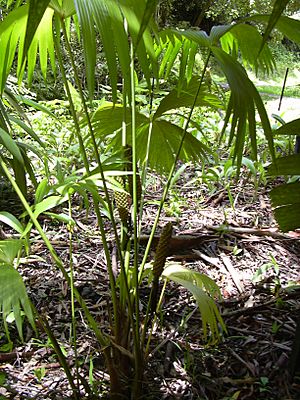Panama hat plant facts for kids
Quick facts for kids Panama hat plant |
|
|---|---|
 |
|
| Conservation status | |
| Scientific classification | |
| Synonyms | |
|
The Carludovica palmata is a special plant known as the Panama hat plant or toquilla palm. Even though it's called a "palm," it's not a true palm tree. It looks a bit like one, but its leaves and stem are different. Unlike real palms, it doesn't grow a hard, woody trunk.
This amazing plant is famous for its strong, soft, and bendy fibers. People use these fibers to weave the famous Panama hats and many other useful items. You can find the Panama hat plant growing in warm places from Central America all the way down to Bolivia in South America.
Contents
What Makes It Special?
The Panama hat plant is a type of monocot plant. This means its seeds have only one "seed leaf" when they sprout. It belongs to a plant family called Cyclanthaceae, which is different from the true palm family (Arecaceae).
Leaves and Stems
The leaves of the Panama hat plant are large and fan-shaped. They look a lot like the leaves of some palm trees. However, the plant does not grow a tall, woody trunk like a true palm. Instead, it has a short, thick stem that stays close to the ground.
Flowers and Reproduction
The Panama hat plant has interesting flowers that help it make new plants. It has both male and female flowers on the same plant. The female flowers grow first and have large parts called stigmas, which are ready to catch pollen. Later, the male flowers grow and produce a lot of pollen. This pollen is then carried by wind or insects to the female flowers, allowing the plant to reproduce.
Where It Grows
The Panama hat plant thrives in tropical rainforests. It prefers warm, humid climates and rich soil. You can find it naturally in countries like Ecuador, Colombia, Peru, and parts of Central America. It often grows in the understory of forests, meaning it grows beneath the taller trees.
The Famous Panama Hat
The most well-known product made from the Carludovica palmata is the Panama hat. These hats are famous for being lightweight, breathable, and stylish. They are often worn in warm weather.
How Hats Are Made
Making a Panama hat is a very detailed process. First, the young leaves of the plant are harvested. Then, they are carefully split into thin, strong fibers. These fibers are boiled and dried. After that, skilled weavers hand-weave the fibers into hats. This weaving can take anywhere from a few days to several months, depending on how fine the hat is. The finest hats are known for their incredibly tight weave.
More Than Just Hats
Besides hats, the fibers from the Panama hat plant are used to make other things. These include baskets, mats, and other woven crafts. The plant's durability and flexibility make it perfect for these items.
See also
 In Spanish: Carludovica palmata para niños
In Spanish: Carludovica palmata para niños


